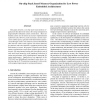14 search results - page 2 / 3 » L1 Data Cache Power Reduction Using a Forwarding Predictor |
CF
2005
ACM
13 years 7 months ago
2005
ACM
Power consumption within the memory hierarchy grows in importance as on-chip data caches occupy increasingly greater die area. Among dynamic power conservation schemes, horizontal...
HPCA
2004
IEEE
14 years 6 months ago
2004
IEEE
Recent research suggests that there are large variations in a cache's spatial usage, both within and across programs. Unfortunately, conventional caches typically employ fixe...
IPPS
2007
IEEE
14 years 1 days ago
2007
IEEE
— Modern CPUs operate at GHz frequencies, but the latencies of memory accesses are still relatively large, in the order of hundreds of cycles. Deeper cache hierarchies with large...
MDM
2005
Springer
13 years 11 months ago
2005
Springer
Data access prediction has been proposed as a mechanism to overcome latency lag, and more recently as a means of conserving energy in mobile systems. We present a fully adaptive p...
DATE
2003
IEEE
13 years 11 months ago
2003
IEEE
This paper presents a on-chip stack based memory organization that effectively reduces the energy dissipation in programmable embedded system architectures. Most embedded systems ...

